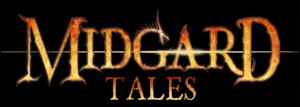 The kobolds have been working hard on several projects (as usual). You can see some of the fruits of their past labor in today’s column, and you can join in on the fun of creating new fodder for your gaming table in the Midgard Tales Kickstarter. Take a peek at this saint by Christina!
The kobolds have been working hard on several projects (as usual). You can see some of the fruits of their past labor in today’s column, and you can join in on the fun of creating new fodder for your gaming table in the Midgard Tales Kickstarter. Take a peek at this saint by Christina!
St. Whiteskull of Bratislor
Legion Lord, Dwarf Slayer, He Who Chooses War over Hunger, the Skull of Bratislor, the Sword of the Imperium, the Warring Ghoul
Domains: Death, Glory, Nobility, War
Subdomains: Heroism, Leadership, Tactics, Undead
Alignment: Neutral Evil
Favored Weapon: Greatsword
The subterranean-dwelling ghouls and darakhul of the Ghoul Imperium worship St. Whiteskull as a masterful god of war, one who, as a mortal ghoul, brought about the decimation of many of the Imperium’s enemies, including dwarves, svirfneblin, and dark creepers.
His leadership and tactics against larger forces brought him fame and fast promotion, for he excelled at using his enemies’ own troops to destroy them—few ghouls could overcome their hunger to convert the dead to legions, and yet he had managed to control both his and his army’s hunger to meet the greater goal of victory.
The Skull of Bratislor’s tremendous exploits for the Imperium gained Morgau’s attention above, and soon the shroud-eaters recruited Whiteskull and his ghoul followers to aid their wars against their neighbors, particularly the Ironcrag dwarves. With his assistance, they captured the Grisal Marches, which now belong to Morgau.
He led several more successful campaigns against the dwarves before his luck failed.
The dwarves called upon their Ravan connections and sent forth an army of clockwork soldiers immune to the army of ghouls’ paralyzing attacks to destroy them. Furthermore, Whiteskull’s army could not raise any destroyed soldiers against the Cantons, nor could they or the other undead among their ranks subsist upon the metal men. Soon the undead were starving and their ranks in disarray. This troop solution proved very wise for the dwarves, and it was the one tactic the savvy Whiteskull had not counted upon. He fell to his death in battle, and the clockwork solders routed his army.
Worshipers: Darakhul, ghouls, shroud-eaters, and the human followers in the Ghoul Imperium and Morgau and Doresh. Soldiers, nobles, and mercenaries turn to St. Whiteskull to beseech his wisdom in battle.
Symbols and Books: St. Whiteskull’s symbol is a greatsword embedded in a white skull with glowing eyes upon an obsidian disc. His copious journals and maps have been copied prolifically, and his followers compiled them into one vast tome. His servants call this compilation the 26thMartial Book of Mavros, but the priests of the God of War and Thunder so far have refused to accept the text as holy canon.
Famous Shrines and Priests: The most famous Temple of St. Whiteskull lies in Bratislor in Morgau, and it is a small-but-growing temple, for the shroud-eaters and the nobles among their lands still find Whiteskull’s tactics admirable and worth revisiting in their continued goals to expand. Another temple lies in the White City of the Ghoul Imperium, St. Whiteskull’s former home.
Masks: St. Whiteskull is considered a Mask of Mavros as he would appear in undeath. No other known Masks are associated with him.
Other Faiths: The deity is on good terms with the church of Mordiggian, the Hunger God, as well as Marena, the Blood Goddess. His worshipers often work in conjunction with these other faiths to bring battles to victory.
What the Whiteskull Demands:The ability and perseverance to overcome one’s weaknesses to ensure glory and victory, heroism in the face of vast numbers, and nobility in one’s leadership.
If you want more new gaming goodness, head over to the Midgard Tales Kickstarter page and consider becoming a backer!


I like this Christina. I mean, really, you had me at Dwarfslayer! Seriously, though, I find the “troop solution” a very nice twist – the battle of fleshies, undead and clockwork strikes a neat balance and wraps up St. Whiteskull’s demands of his faithful.
And yes, the only good dwarf is a (un)dead dwarf killing his fleshly relatives! Hooray for Morgau!
One point I’m a bit unsure of – under “Other Faiths” you mention “the deity”. Is there a hierarchy in Midgard re: demigods, saints, godlings, deities and gods? Or do “Masks” sweep all such frivolous concerns aside?
Wolfgang can explain best, but as a “mask,” he is a deity, albeit I’d say a demigod–much like Vasilka Soulay of Perunalia, whom I’ll be working on very soon.
Saints don’t really get masks, but greater gods do. There are indeed demi-gods and godlings, though a lot of that is arbitrary.
For instance, Veles is a greater god, the dark gods tend to be lesser (other than Chernovog), and some gods are greater or lesser in certain regions.
Masks aren’t meant to “sweep away” such concerns. They’re actually there to help muddy those waters. Any God/dess might be any other God/dess in disguise, so a given religion’s hierarchy’s approach to another God/dess and ITS religion might easily come into conflict with a PC of the same religion’s moral assumptions. So: A Paladin of Mavros is told by his church not to interfere with Ghoul Clerics of St. Whiteskull. He finds them eating an orphanage for some tactical purpose. Is he REALLY ok with following those orders?
Good job Christina. Gets me even more interested in learning more about the Ghoul Imperium!